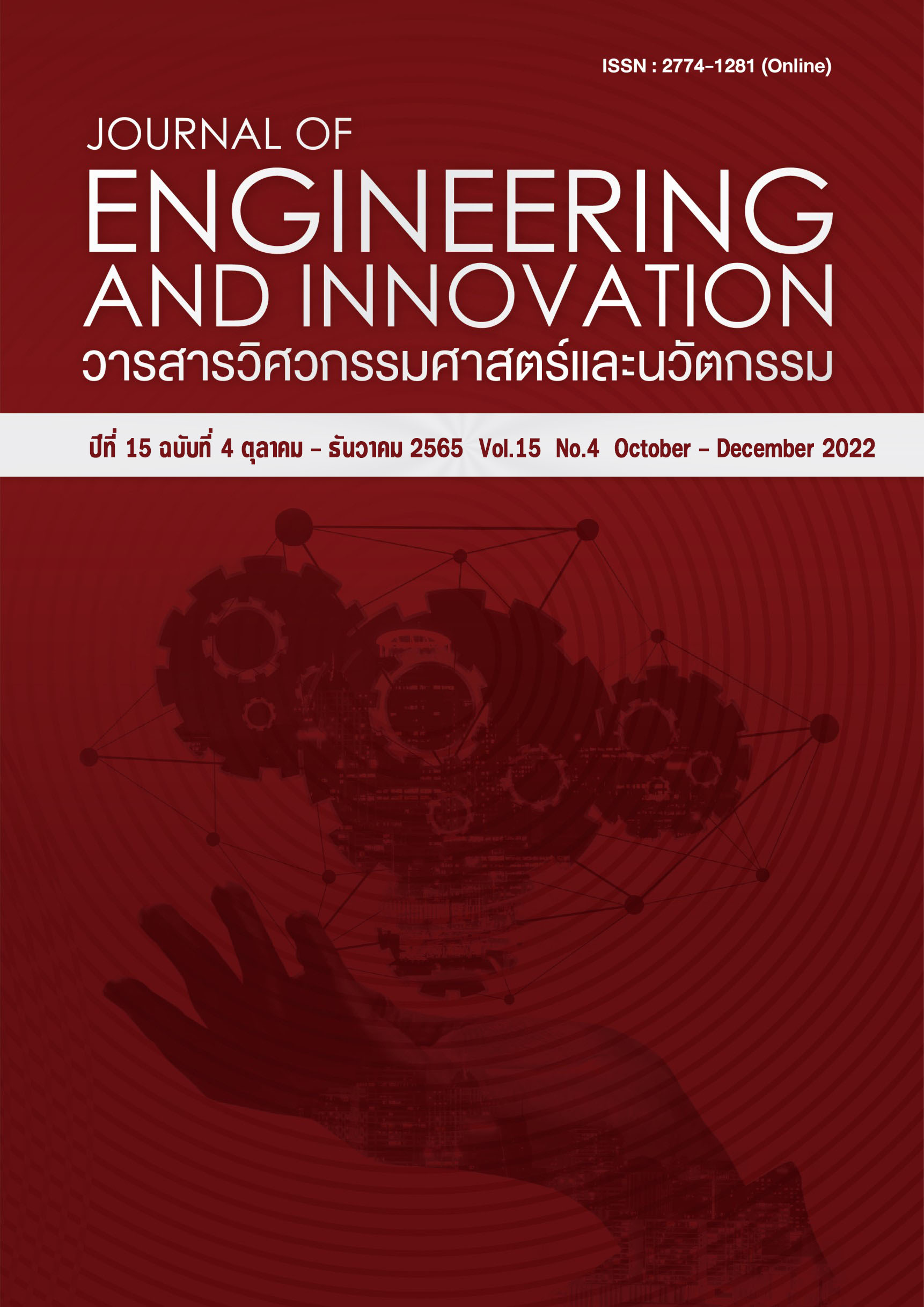Analysis of Food-Safety Chain System using Mixed Method Research and Causal Loop Diagram
Main Article Content
Abstract
This research aims to analyze the food-safety chain system. Initially, both quantitative and qualitative data of stakeholders are evaluated using the mixed methods research (MMR) technique for the case study of Ubon Ratchathani. The questionnaires were collected for four sample groups: farmers, distributor, wet market’s vendors, and consumers. Then, data are analyzed for three parts, which are satisfaction level, factors affecting the system of the food-safety chain, and open-ended questions. Analyzed results show that distributor, vendors, and consumers are similarly concerned with the transportation cost and the available number of logistics providers. Moreover, farmers and vendors are more concerned with product safety during the transportation, while consumers prefer the quality control during shipping. Next, relevant factors are synthesized using the causal loop diagram (CLD), in which the developed model is verified and validated with the provincial food-safety committee's representatives. In particular, the developed CLD consists of 9 loops, which are divided into 6 reinforcement loops (RL) and 3 balanced loops (BL). In addition, analyzed results from CLD can be further extended for policy recommendations of food-safety chain. Given the loop of consumer choice, for example, relevant government agencies are suggested to implement regulations and strategies to promote safe-food manufacturers or entrepreneurs. Such implementations can help to increase both the number and choice of safe-food consumers.
Article Details
References
วารสารวิศวกรรมสาร มก, 32(108).
[2] Chaiyaphan, C., & Ransikarbum, K. (2020). Criteria analysis of food safety using the Analytic Hierarchy Process (AHP)-a case study of Thailand’s fresh markets. In E3S Web of Conferences (Vol. 141, p. 02001). EDP Sciences.
[3] ชีวาพร ไชยพันธ์ และ กสิณ รังสิกรรพุม. การศึกษาปัจจัยและแผนผังตลาดสดด้วยกระบวนการวิเคราะห์เชิงลำดับชั้นและแบบจำลองมอนติคาโล กรณีศึกษาตลาดเอกชนและตลาดเทศบาล. วารสารวิจัย มข. (ฉบับบัณฑิตศึกษา) E-ISSN 2672-9636. (ตอบรับ)
[4] กรณัฐ ปิ่นฉ่ำ, มนฤตย์พล อุรบุญนวลชาติ, & สุพัตรา จุณณะปิยะ. (2558). การพัฒนาตลาดเกษตรแบบยั่งยืน: ศึกษาการมี ส่วนร่วมของเกษตรกร ผู้ผลิตผักปลอดภัยจากสารพิษ โครงการอาหารปลอดภัยตลาดกลางผักและผลไม้จังหวัด ราชบุรี. วารสารสหวิทยาการวิจัย: ฉบับบัณฑิตศึกษา, 4(2), 122-132.
[5] Ransikarbum, K., Ha, S., Ma, J., & Kim, N. (2017). Multi-objective optimization analysis for part-to-Printer assignment in a network of 3D fused deposition modeling. Journal of Manufacturing Systems, 43, 35-46.
[6] Ransikarbum, K., & Mason, S. J. (2016a). Multiple-objective analysis of integrated relief supply and network restoration in humanitarian logistics operations. International Journal of Production Research, 54(1), 49-68.
[7] Ransikarbum, K., & Mason, S. J. (2016b). Goal programming-based post-disaster decision making for integrated relief distribution and early-stage network restoration. International Journal of Production Economics, 182, 324-341.
[8] Puchongkawarin, C., & Ransikarbum, K. (2020). An Integrative Decision Support System for Improving Tourism Logistics and Public Transportation in Thailand. Tourism Planning & Development, 1-16.
[9] Wattanasaeng, N., & Ransikarbum, K. (2021). Model and Analysis of Economic-and Risk-Based Objective Optimization Problem for Plant Location within Industrial Estates Using Epsilon-Constraint Algorithms. Computation, 9(4), 46.
[10] Ransikarbum, K., & Wattanasaeng, N. (2021). Optimization Model for Industrial Estate Planning under Safety Criterion. Naresuan University Engineering Journal, 16(1), 81-93.
[11] Ransikarbum, K., Pitakaso, R., & Kim, N. (2020). A decision-support model for additive manufacturing scheduling using an integrative analytic hierarchy process and multi-objective optimization. Applied Sciences, 10(15), 5159.
[12] ศิริพล ภูปุย, & มนกานต์ อินทรกำแหง. (2559). การพัฒนาการดำเนินงานอาหารปลอดภัยในตลาดชุมชน ตำบลโพน อำเภอ คำม่วง จังหวัดกาฬสินธุ์. วารสารวิจัยทางวิทยาศาสตร์สุขภาพ, 10(2), 50-60.
[13] Estay, D. A. S., & Pankaj, G. (2020). Review of the application of System Dynamics to problems in food supply chains. In 38 International Conference of System Dynamics Society.
[14] ชวนชม เหลืองตั้งวโรดม. (2561). กลยุทธ์การประยุกต์ใช้ Open innovation ในอุตสาหกรรมธนาคารไทย. สารนิพนธ์ปริญญาการจัดการมหาบัณฑิต, วิทยาลัยการจัดการ มหาวิทยาลัยมหิดล.
[15] นุศราพร เกษสมบูรณ์, ฉัตรสุดา ธีฆะพร, ธมลวรรณ โพธาราม และสุภนัย ประเสริฐสุข. (2561). การวิเคราะห์วงรอบเหตุและผลของการใช้สเตอรอยด์ในทางที่ผิดระดับชุมชน. วารสารเภสัชศาสตร์อีสาน, 14(2), 56-69.
[16] บวรศม ลีระพันธ์, ระพีพงศ์ สุพรรณไชยมาตย์, พาส์น ฑีฆทรัพย์, แพรวนภา พันธุ์สวาสดิ์, วรารัตน์ ใจชื่น, วรสิทธิ์ ศรศรีวิชัย, ปณิธี ธัมมะวิจยะ, ภาณุวิชญ์ แก้วกำจรชั. (2563). การพัฒนาแบบจำลองบูรณาการระบบการแก้ไขปัญหาโรคติดเชื้อไวรัสโคโรนา 2019 เพื่อสนับสนุนกระบวนการตัดสินใจเชิงนโยบาย. สถาบันวิจัยระบบสาธารณสุข.
[17] Karami, S., Karami, E., Buys, L., & Drogemuller, R. (2017). System dynamic simulation: A new method in social impact assessment (SIA). Environmental Impact Assessment Review. 62, 25-34.
[18] Kirkwood C. W. (1998). System dynamics methods: A quick introduction. College of Business: Arizona State University.

